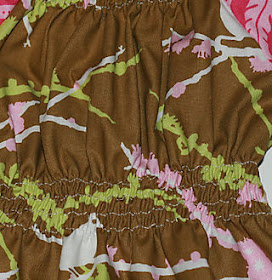
We had a chat with our very own, Chelsea Anderson of Pink Fig Design and the designer of the line, Amelie. She's a busy mom and for her latest venture, she's started working with the awesome folks at Zulily. Look at the beautiful designs that she's been working on!

These gorgeous outfits are in her shop now. Make sure that you check them out! The outfits are so perfect for the season.

We think that Chelsea should sew up some adult-sized ones for us to wear!

Chelsea wrote up this amazing tutorial for us on shirring. Thanks for the clear instructions and great photos!
1. To get started you will need some elastic thread and a bobbin. I buy my elastic thread at my local fabric shop and it looks like this:

2. Hand-wind your elastic thread onto the bobbin. Don't try to wind it using your machine. It will pull the elastic too tight and this will cause your shirring to be tight and the thread to break. When you are hand-winding you can pull on it a tiny bit to help keep the thread even on the bobbin, but don't pull too tight or you will cause the thread to break while you are shirring. After it is wound, it should look like this:

3. You will use the elastic thread on the bobbin and regular thread on the top of your machine. you can match your thread to the color of your fabric on top since the elastic thread will only be showing on the inside of the piece that you are sewing.
If you have a non-computerized sewing machine, in most cases, you will want to set your stitch length to 4 and leave your tension where you have it for regular sewing and you will sew with a straight stitch. If you find that the elastic is too loose or too tight on the back then you will want to adjust your tension. If you are still having trouble with your elastic then you might want to make sure the elastic thread isn't on the bobbin too tight. Practice on scraps first to make sure that you have it right. Straight stitch shirring looks like this:

Computerized sewing machines often times have a shirring stitch built in. I have a Babylock Espire and my machine has a stitch called the elastic zig zag stitch. It sets the tension for me and I just have to choose the stitch width and length. I set my length to 3.5 and width to 4. Elastic zig zag stitching looks like this:

Either stitch works great, but depending on your machine, you may need to play around with your tension and stitch length to get it right.
4. When you are ready to start make sure you have about 1" of elastic thread pulled from the bobbin so that you have enough to tie it off with your ending piece. Start sewing on a side seam with the top ofyour fabric facing up and the bottom of your fabric against the machine. you want to see your regular thread on top NOT the elastic thread. That should only be seen on the back side of your fabric.

When shirring around a neck line or on short sleeves, I like to start about 1/4" away from the edge so that it gives it a cute ruffled look. I usually space my rows 1/4" apart on sleeves, necklines, and chestlines. If I am doing several rows of shirring for a bodice or something around the chest, I set my rows 1/2" apart. Sometimes if you put your rows too close together it makes the shirring really tight.

Once you have gone all the way around to where your threads meet up, make sure that you leave about an inch of elastic thread so you can tie it off with the starting piece. Gently tie 3-5 knots trying not to break the thread:

This is what your rows of shirring should look like from the inside:

When you are all done with your shirring to tighten the elastic thread, steam it with an iron. Don't pull on the threads to tighten them, they will break! After you steam the elastic it should shrink up to look like this:


All done!
Thank you, Chelsea for spending some time with us! Have you ever tried shirring? What other techniques are you interested in learning?
Remember to enter our giveaway!

Really cute - wish I had some little girls to sew for!
ReplyDeletehow pretty and sooo springy!!!!love it!
ReplyDelete